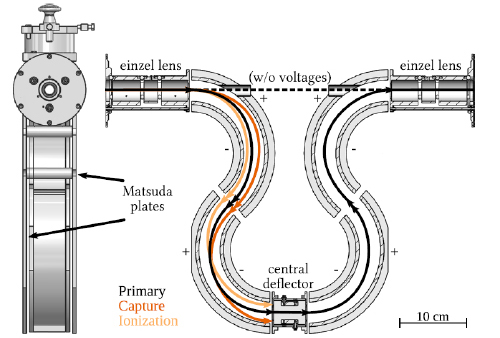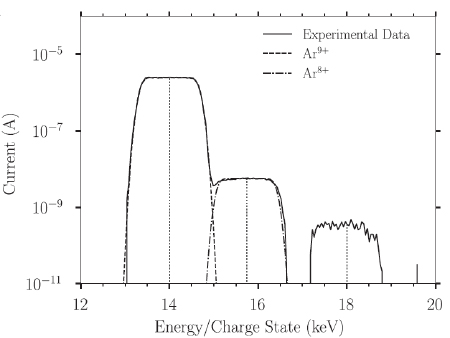List of members |
Facilities |
Internships and jobs |
PhD |
Publications |
News |
For many experiments dealing with slow multicharged ions interacting with matter, a good control of the charge state upstream the collision is important. This is especially true in cases in which the charge state products are measured in coincidence, for example, in ion-surface/2D material experiments or ion-ion studies.
As highly charged slow ion beams can undergo significant charge exchange scattering with the residual gas molecules it becomes necessary to insert a charge state selection system close to the experimental area. For low energetic ion beams it is convenient to utilize electric fields for this purpose. To maintain the axis of propagation of the ion beam an omega shaped purification system consisting of four 140° cylindrical deflectors has been developed, installed and tested (figure 1).

Figure 1: Side view and schematic cut through the purification system. The cylindrical deflectors are enclosed between Matsuda electrodes. The polarity of the deflector electrodes for positive ion beams is indicated by plus and minus signs. The black beam resembles the primary ion beam which transits the structure at the effective radius. Beams with lower (capture, dark orange) or higher (ionization, light orange) charge state are sorted out by hitting the wall of the deflector.
Different charge states with the same kinetic energy have different trajectories inside the structure so that ions which underwent ionization or capture in residual gas collisions can easily filtered out with beam apertures cutting away the outer beams. Focusing of the beam is achieved by the element Einzel lenses at the beginning and the end of the structure as well as due to the intrinsic focusing of the cylindrical deflectors in the plane of deflection. For additional focusing perpendicular to this plane Matsuda electrodes are installed.
An energy-scan procedure (i.e. by scanning the voltages applied on the electrodes) has allowed us to experimentally determine the resolving power and identify the presence of unwanted charge states in the incoming primary beam. An example is given in figure 2: we can observe that the unwanted Ar8+ and Ar7+ ions are well separated from the Ar9+ ion beam.

Figure 2: Energy scans of a 14qkeV Ar9+ primary beam (solid black line). The dashed line is a fit of the primary charge state q0, and the dotted-dashed line is a fit of the single electron capture charge state q0 − 1. Vertical dotted lines represent the expected center of each charge state.
A resolving power of 10.5 and a transmission of 100% of the desired charge state have been measured allowing a good purification of incoming ion beams with charge states up to 10+ and a fairly good purification for charge states at least up to 20+.
Collaborations
The device has been developed in collaboration with A Mery, J Rangama from the team AMA at CiMAP (Caen). It has been firstly tested at the ARIBE facility and mounted and re-tested successfully at the SIMPA installation.

